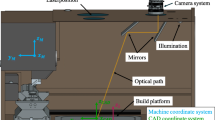Abstract
Since the additive manufacturing machines are not in mass production, there are usually differences between machines from the same brand and model. In previous production tests done in powder bed fusion (PBF) machines, large deviations have been discovered. Therefore, a method for measuring the accuracy of the additive machine is necessary. A new method has been developed, with characteristics similar to those of a coordinate measuring machine (CMM). The CMM method has been inverted, and through a nonlinear optimization process, reconfigures certain key points to make an analysis of the machine accuracy. Using this method, one can detect abnormalities or deviations in the laser positioning, or find that the machine make parts that have certain offsets which deviate from that of the computer model. The developed test will help include the additive machining center into an automated hybrid cell, where traditional CNC-machines interact and all machines work under a common cell control system. The new method has been simulated and applied in the workshop, where it has been found that the product deviations has been reduced to almost a fifth of the original value.
Similar content being viewed by others
References
Ahn D, Kim H (2007) Lee, S, Fabrication direction optimization to minimize post-machining in layered manufacturing, International Journal of Machine Tools and Manufacture
Akasawa T (2003) Effects of free-cutting additives on the machinability of austenitic stainless steels. J Mater Process Technol 143–144: 66–71
Boivie K, Soerby K, Broetan V, Ystgaard P Development of a hybrid manufacturing cell: integration of additive manufacturing with CNC machining (2011), Twenty Second Annual International Solid Freeform Fabrication Symposium, 153–163
Brajlih T, Valentan B, Balic J, Drstvensek I (2011) Speed and accuracy evaluation of additive manufacturing machines. Rapid Prototyp J 17: 64–75
Byrd RH, Hribar ME, Nocedal J (1999) An interior point algorithm for large-scale nonlinear programming. SIAM J Optim 9(4):877
ConceptLaser (2011) Applying the laser-fusing of metal in mould making. Eur Tool & Mould Making: 48
Dimitrov D, Wijck WV, Schreve K, Beer ND (2006) Investigating the achievable accuracy of three dimensional printing. Rapid Prototyp J 12(1):42–52
Hu D, Kovacevic R (2003) Sensing, modeling and control for laser-based additive manufacturing. Int J Mach Tools Manuf 43(1):51–60
ISO 10360-5 (2010), Part 5: Geometrical product specification (GPS)—acceptance and reverification test for coordinate measurement machines(CMM), European Committee of standardization, Geneva, Switzerland
Kakino Y (1987) The Measurement of motion errors of NC machine tools and diagnosis of their Origins by using telescoping magnetic ball bar method. CIRP Ann—Manuf Technol 36(1):377–380
Khaing M (2001) Direct metal laser sintering for rapid tooling: processing and characterisation of EOS parts. J. Mater Process Technol 113(1–3):269–272
Kiekens K, Welkenhuyzen F, Tan Y, Bleys P, Voet A, Kruth JP, Dewulf W (2011) A test object with parallel grooves for calibration and accuracy assessment of industrial computed tomography (CT) metrology. Meas Sci Technol 22(11):115502
Kruth JP, Bartscher M, Carmignato S, Schmitt R, De Chiffre L, Weckenmann A (2011) 60(2):821–842
Lei W, Sung M, Liu W, Chuang Y (2007) Double ballbar test for the rotary axes of five-axis CNC machine tools. Int J Mach Tools Manuf 47(2):273–285
Nocedal J, Wright S (2009) Numerical optimization (Springer Series in Operations Research and Financial Engineering), Springer (2009), ISBN-10: 0387303030, ISBN-13: 978-0387303031, 2nd edn
Pessard E, Mognol P, Hascoët JY, Gerometta C (2007) Complex cast parts with rapid tooling: rapid manufacturing point of view, The International Journal of Advanced Manufacturing Technology
Roberts IA, Wang CJ, Esterlein R, Stanford M, Mynors DJ (2009) A three-dimensional finite element analysis of the temperature field during laser melting of metal powders in additive layer manufacturing. Int J Mach Tools Manuf 49(12-13):916–923
Sinirlioglu MC (2009) Rapid manufacturing of dental and medical parts via laserCUSING Technology using Titanium and CoCr Powder Materials. RapidTech: 2009
Spellucci P (1998) A new technique for inconsistent QP problems in the SQP method. Math Meth Oper Res 47(3):355–400
The MathWorks Inc, MATLAB Optimization Toolbox. Version 6.0, 23.02.2012, 2012
Tone K (1983) Revisions of constraint approximations in the successive QP method for nonlinear programming problems. Math Program 26(2):144–152
Tozawa K, Toida N, Kobayashi Y, Shirai K (2010) Estimation of machining accuracy by measurement of surface texture pattern. Int J Autom Technol 4(5):415–421
Venkataraman P Applied optimization with MATLAB programming, Wiley (2009), ISBN-10: 047008488X, ISBN-13: 978-0470084885, 2 edn
Zhou JG, Herscovici D, Chen CC (2000) Parametric process optimization to improve the accuracy of rapid prototyped stereolithography parts. Int J Mach Tools Manuf 40(3):363–379
Author information
Authors and Affiliations
Corresponding author
Rights and permissions
About this article
Cite this article
Brøtan, V. A new method for determining and improving the accuracy of a powder bed additive manufacturing machine. Int J Adv Manuf Technol 74, 1187–1195 (2014). https://doi.org/10.1007/s00170-014-6012-3
Received:
Accepted:
Published:
Issue Date:
DOI: https://doi.org/10.1007/s00170-014-6012-3




